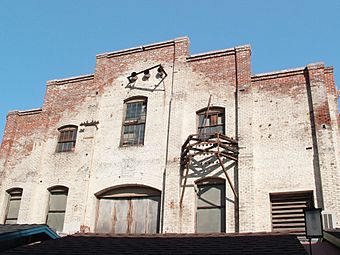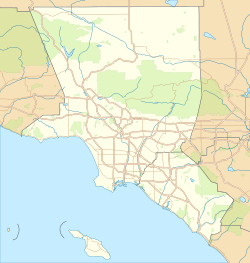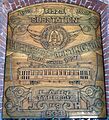Plaza Substation facts for kids
Quick facts for kids |
|
|
Plaza Substation
|
|
 |
|
| Location | 10 Olvera St., Los Angeles, California |
|---|---|
| Built | 1905 |
| Architectural style | Mission/Spanish Revival |
| NRHP reference No. | 78000689 |
| Added to NRHP | September 13, 1978 |
The Plaza Substation was an important building in Los Angeles, California. It was an electrical substation that helped power the city's "Yellow Car" streetcar system. This system ran from the early 1900s until 1963. After the streetcars stopped, the building was almost torn down in the 1970s. But people fought to save it, and it was added to the National Register of Historic Places in 1978. This means it's a special historic landmark.
Contents
Building the Plaza Substation
In May 1903, Henry E. Huntington owned the Los Angeles Railway. He announced plans to build a new substation. This substation would be near the old plaza in Los Angeles. The Los Angeles Times newspaper reported on this big project. They said it would help make the streetcar system even better.
By 1905, the Plaza Substation was up and running. The Times explained how it worked with other substations. Electricity was made at a main power station. Then, it was sent to four smaller substations around the city. The Plaza Substation was one of the most important. It distributed about 40 percent of the power used for the streetcars. The other substations handled the rest.
End of the Yellow Car System
The "Yellow Car" streetcars were a big part of Los Angeles life. But they stopped running in 1963. The Plaza Substation building was located near Olvera Street. This is an old Mexican marketplace in the city. After the streetcars stopped, the building was used for other things.
However, some people thought the building didn't fit in with the old look of Olvera Street. They wanted to tear it down. In 1971, a historian named Dr. Doyce Nunis said the substation had no important historical value. He felt its design was common and no famous architect had designed it.
Saving the Historic Building
After hearing the historian's report, the city's Recreation and Parks Commission voted to demolish the building. They wanted to replace it with a new market. Mayor Tom Bradley supported this plan.
But then, John Pastier, a writer for the Los Angeles Times, spoke out. He wrote an article asking why a historic building should be torn down. Pastier pointed out that the Plaza Substation was the largest and most unique of the remaining streetcar substations. He suggested the city could make it a tourist attraction. He gave examples like Ghirardelli Square in San Francisco.
Others also joined the debate. The State Park Department's director opposed the demolition. He felt the city was turning a historic park into an amusement park. Some writers at the Times even disagreed with each other. One writer thought saving the substation was not necessary.
A group called Californians for Preservation Action took legal action. They filed a lawsuit to stop the demolition. A state court judge then issued an order to halt the demolition. Finally, the Plaza Substation was saved. Funds were set aside to fix it up as part of a settlement in 1978.
Historic Landmark Status
The Plaza Substation is now a very special building. It is one of only two buildings in the Los Angeles Plaza Historic District that is also listed separately on the National Register of Historic Places. It received this important status in September 1978.
Images for kids





